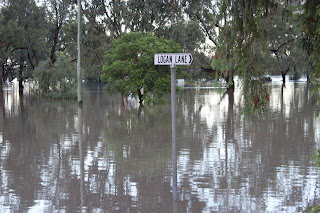While Europe and North America wallow in recession, some stunning economic results appeared down-under today. Official statistics revealed today that Australia's economy grew overall by 2.7% in 2009, the fastest in the OECD, and industrial investment is soaring. Coupled with heavy downpours of rain over much of rural NSW and Queensland, which should dramatically increase agricultural output, we can now expect GDP to rise well above the 3% long-term growth rate in 2010 - perhaps reaching 4%.
And the mineral and energy sector is once again booming. The $50+ billion investment in a single project - the Gorgon natural gas field - is a case in point. When in production, it will have the single largest gas output of any project in the world, and it will equal a whopping 8% of current world gas production. Australia's status as a gas producer might then equal Saudi Arabia's in oil production.
A further up-side to all this is that the A$ today soared above UK 60p. Earlier in the naughties, it was valued at just 36p. The currency has also suddenly risen against the Euro reaching 66 cents. Just a year ago, at the height of the GFC, it plunged to about 55 cents. The up-side is most likely to be felt by those travelling overseas, or shoppers buying cheap manufactured goods. A high valued currency trims the income of mining companies and farmers, which isn't so good.
Then, of course, there is another down-side. A booming economy attracts higher interest rates, and yesterday the Reserve Bank Board raised them by a further 25 basis points (or 0.25%) to 4%. This is the fourth such increase in the last 6 months, a solo run among the OECD countries whose interest rates are mostly bumping along near zero. The latest rise was partly inspired by the need to rein in rises in real estate prices, which are now also rising fast.
Rising interest rates have yet, however, to dim consumer confidence which is running at a high level, that buoyed by falling unemployment which is now trending towards 5%, about half that in Europe and North America. That's just as well because another benefit is cutting in. Government tax receipts are rising strongly, helping governments to regain their annual fiscal surpluses and eliminate public sector debt. And, whereas most OECD countries record debt to GDP ratios in the range of 80% to 120%, Australia's is forecast to peak at only about 12% next year - a fantstic position to be in.
Perhaps my overseas readers might press for their governments to import Ken Henry, Treasury Secretary, Glen Stevens - Boss of the Reserve Bank, and Gary Banks of the Productivity Commission to explain how this was all done and advise appropriate strategies. I've been discussing precisely these themes with a despondent Greek colleague, angry at national mismanagement.
And, on top of everything I've just said, immigration is rising sharply, thereby retarding the ageing of society - a problem that increasingly bedevils much of Europe and North Asia. That's another long-term plus. Young migrants will be employed for a long time and they, in turn, will start families. The nation's population is tipped to rise 55% over the next 40 years! Not only that, but our export markets are increasingly focusing on Asia. Consider also this. The world's population is now about 6.6 billion people. Of these 2.7 billion lie immediately to our north, and many of the nations involved (especially China, India, Vietnam, Indonesia, Thailand, and Malaysia) have experienced rapid economic growth even through the GFC. Huge opportunities are looming as quarry, farm, holdiday destination, and education provider for the wealthy masses of our region. Even if only 40% of the region's population attain comfortable middle class status, we're looking at a market of > 1 billion people for all these goods and services, or double the size of the European Union or 3 times the population of North America.
The 21st century will be the Asian (or Western Pacific) century and I'm beginning to see more clearly the ebbing of power and influence of the North Atlantic region and the relative dynamism of our back-yard. This is mirrored, too, in the Heritage Foundation's Index of Global Economic Freedom. The first four nations are: Hong Kong, Singapore, Australia and New Zealand!! Many European nations are well down the list with, for example, Greece coming in at about 75th. Can European social democracy be fixed or does it have terminal problems?
I hope this lengthy posting gives you food for thought, and I'd welcome comments on any of the issues I've raised.
AS



























